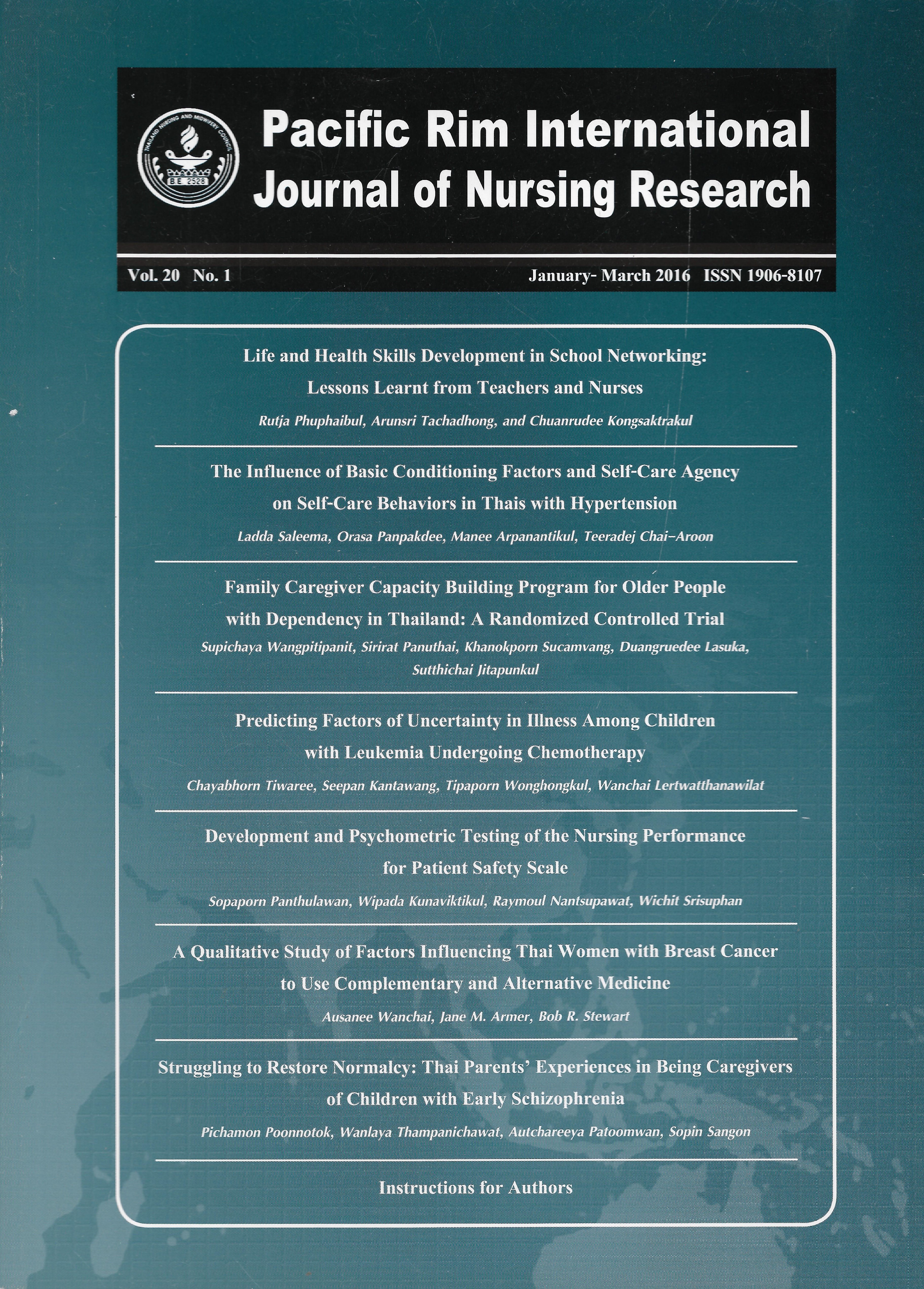Life and Health Skills Development in School Networking: Lessons Learnt from Teachers and Nurses
References
1. World Health Organisation. WHO’s Global School Health Initiative: Health-Promoting Schools. WHO/HPR/ HEP/98.4. Geneva: WHO; 1998.
2. UNICEF. Information Series on School Health. http://www.unicef.org/lifeskills/files/SkillsForHealth230503.pdf. (Accessed 3 July 2015).
3. American Academy of Pediatrics Council on School Health. School Health. https://www2.aap.org/sections/ schoolhealth/resources.htm. (Accessed 15 December 2014).
4. National School Board Association. School Health Programs. http://www.nsba.org/SchoolHealth. (Accessed 15 December 2014).
5. Eakajumpaka P, Watamano N. Food consumption behavior of Thai People in the New Era. Thai Health Situation 2009; 3(2): 1-31.
6. Office of National Statistics. Executive Summary: Children and Youth Survey 2008. Bangkok: Text and General Publication; 2009.
7. Ramajitti Institute. Child and Youth Situation in Child Watch Project. http://www.childwatchthai.com/download. htm. (Accessed 1 May 2014).
8. Division of Health Education. The Health Promoting School . http://eng.anamai.moph.go.th/main.php?filename=02_ thps. (Accessed 1 May 2014).
9. Kerddonfak P, Sanongdet W. Health status of primary school students: A Case study of the Central Region of Thailand. J. of Health Science 2007; 16(5): 795-803.
10. Health Promotion Office, Department of Health. Annual Report 2008. Nonthaburi: Ministry of Public Health; 2009.
11. Phuphaibul R, Kerddonfeg P, Areeyanuchitkul S. Chantarachote J. Comparison the effects of Life Skill Delopment Program using cartoon books and 3D animation movies on life skill of school-agers. Ramathibodi Nurs. J. 2014; 20(2): 271-287.
2. UNICEF. Information Series on School Health. http://www.unicef.org/lifeskills/files/SkillsForHealth230503.pdf. (Accessed 3 July 2015).
3. American Academy of Pediatrics Council on School Health. School Health. https://www2.aap.org/sections/ schoolhealth/resources.htm. (Accessed 15 December 2014).
4. National School Board Association. School Health Programs. http://www.nsba.org/SchoolHealth. (Accessed 15 December 2014).
5. Eakajumpaka P, Watamano N. Food consumption behavior of Thai People in the New Era. Thai Health Situation 2009; 3(2): 1-31.
6. Office of National Statistics. Executive Summary: Children and Youth Survey 2008. Bangkok: Text and General Publication; 2009.
7. Ramajitti Institute. Child and Youth Situation in Child Watch Project. http://www.childwatchthai.com/download. htm. (Accessed 1 May 2014).
8. Division of Health Education. The Health Promoting School . http://eng.anamai.moph.go.th/main.php?filename=02_ thps. (Accessed 1 May 2014).
9. Kerddonfak P, Sanongdet W. Health status of primary school students: A Case study of the Central Region of Thailand. J. of Health Science 2007; 16(5): 795-803.
10. Health Promotion Office, Department of Health. Annual Report 2008. Nonthaburi: Ministry of Public Health; 2009.
11. Phuphaibul R, Kerddonfeg P, Areeyanuchitkul S. Chantarachote J. Comparison the effects of Life Skill Delopment Program using cartoon books and 3D animation movies on life skill of school-agers. Ramathibodi Nurs. J. 2014; 20(2): 271-287.
Downloads
Published
2016-01-25
How to Cite
1.
Phuphaibul R, Tachadhong A, Kongsaktrakul C. Life and Health Skills Development in School Networking: Lessons Learnt from Teachers and Nurses. PRIJNR [internet]. 2016 Jan. 25 [cited 2025 Dec. 25];20(1):1-4. available from: https://he02.tci-thaijo.org/index.php/PRIJNR/article/view/47174
Issue
Section
Editorial
License
Copyright: The Pacific Rim International Journal of Nursing Research, Thailand Nursing & Midwifery Council has exclusive rights to publish, reproduce and distribute the manuscript and all contents therein.








.png)



